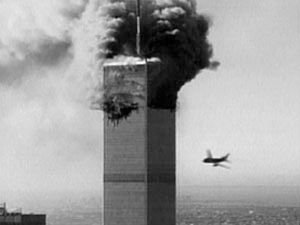[Fall 2001]
by Jacques Doyon
The terrorist attack of September 11 took the impact of the media image to new heights, with the inclusion in its scenario of the moment when various cameras enabled the entire world to witness the event live and left us for hours in fear of what might come next.
For anyone who is at all interested in the fabrication and impact of the image in our societies, this media misappropriation is truly stunning. The unfolding of the attack, and its mise en scène, both condensed and surpassed all catastrophic scenarios with which the American film industry constantly swamps us. Executed with resources that are tiny compared to those that Hollywood or the American army could deploy, it suddenly exposed the weakness of the spectacle of the shelling of Iraq, with its “sound and light” aesthetic and its symbols of fireworks and cannonades. These shrank to insignificance compared with the shattering evoked by the images of the attack and the abyss that it suddenly opened in the heart of our democracies.
Shattering comes from the exact similitude of the scenario of this operation with what constitutes the normal cathartic imagery of the United States, which enables it to sublimate the violence underlying a planetary disequilibrium. It also comes from the fact that this “spectacle” responds very precisely to the “intensified experience” that an audience seeking more reality and “real” sensations (CNN and the Gulf war, reality TV, snuff movies, etc.) is constantly craving. In addition, if it is true that this operation was conducted by Moslem extremists, we must recognize that, although their culture is founded on an execration of the image, these people have been brilliant students of America, perfectly mastering the effects and impact of the image. We are still in shock at having watched, live, a symbolic emasculation of America. And by thus providing the West with the exact measure of everything that is current in all other parts of the world, on thus creating a very precise intersection of the image with the reality, this event has broken through the anaesthetizing effect of our imagery of violence. And this is precisely because of its unbearable and horrific nature. For, in our societies of the image, explicit images of war are controlled and censored.
This event is horrifying not only because of the number of civilian casualties and the possible escalation that it may lead to, but also because it throws light on the weaknesses and responsibilities of our democratic societies. As we are beginning to discover, the situation is much more complex than it seems at first glance. Some commentators have emphasized the fact that extremist factions exist only because entire societies see themselves excluded by everything that the media images throw at them. And we must not forget that the arms industry, one of the major sinews of the economy, will have as customers tomorrow the enemies that it has today. The only hope that we can have right now is that the current crisis will not lead to more war, but that it will enable us to “civilize” the violence by integrating and recognizing the rights of those left behind by globalization.
For democracy has always fundamentally corresponded to one thing: the gradual inclusion of those who were excluded. Each time, this broadening of inclusion is accompanied by a questioning of the image with which the society has endowed itself and its members. Each time, the border – the edge where difference becomes an impenetrable barrier and is transformed into exclusion – is pushed a little farther back. In this issue, we invite you to probe the stakes in these cultural frontiers…

